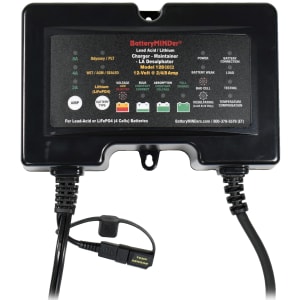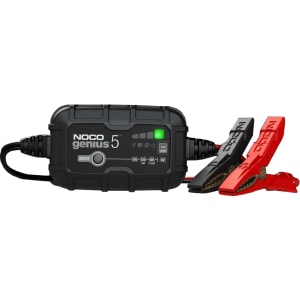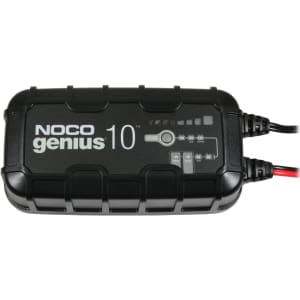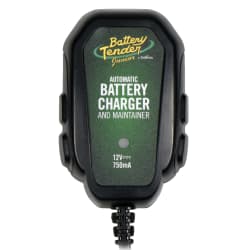What Size Battery Charger Do I Need?
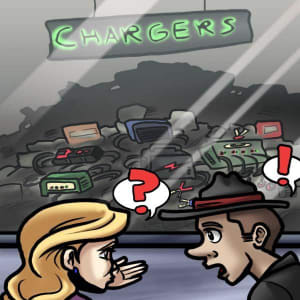
Let me start with a disclaimer: BatteryStuff.com does not sell those cheap, off-the-shelf battery chargers often found at retail outlets and certain other online stores. We cater specifically to microprocessor-controlled chargers, also known as smart chargers and maintainers. All our chargers are reviewed, tested, and selected based on function, reliability, and durability.
Our smart battery chargers utilize computer-generated algorithms designed to charge specific battery chemistries, such as flooded, AGM, Gel, or lithium batteries. Simply put, most of our chargers collect information from the battery and/or user and adjusts the charge current and voltage based on this information.
This allows the battery to be charged quickly, correctly, and completely when using a smart charger. Most of the chargers we sell can remain connected to a battery indefinitely and will not overcharge or damage a battery.
Simple steps to select the right Battery Charger for your needs:
Step 1: Choosing a Charger Based on Battery Type
To select the right charger, you need to know your battery’s chemistry.
Common battery types found in most applications are maintenance-free, wet cell (flooded), AGM (absorbed glass mat), gel cell, VRLA (valve-regulated lead acid), or lithium.
We can often recommend a single charger with a multi-amp and profile setting for those with various battery types. The benefit to these types of chargers is you can charge a small motorcycle or ATV battery up to a large deep-cycle marine battery:
Schauer Charge Master CM12A | 12v 1/8/12 Amp Multi-Stage Smart Charger
- Part# CM12A
- Ideal for 4AH to 240 AH
- Works on Flooded, AGM, Gel, and Calcium Lead Acid Batteries
- Fan Cooled
- Ideal for Powersport Batteries, Car & Truck Batteries, or maintaining up to a 240 AH RV battery pack!
BatteryMINDer 128CEC2 | 12v 2/4/8 Amp Smart Charger Maintainer Desulfator
- Part# 128CEC2
- Ideal for 8AH to 240 AH
- Works on PLT (Pure Lead Tin), Odyssey Brand Batteries, Flooded, AGM, Sealed, and Lithium Batteries
- Full-time 100% Pulse Desulfation for Lead Acid Batteries.
- Ideal for Powersport Batteries, Car & Truck Batteries, or maintaining up to a 240 AH RV battery pack!
- Intrusion Protected (water, moisture, dust) to IEC IP 65
Step 2: Determining Battery Size
We don’t mean physical size but the battery capacity, often referred to in an AH (amp/hours) rating.
For example, a typical car battery is about 50 AH but could be as much as 100 AH. So ideally, you would choose a 5 to 10 amp charger that would take about 6-12 hours to recharge if the battery was completely dead.
NOCO Genius 5 | 12v 5 Amp Smart Battery Charger & Maintainer
- Part# GENIUS5
- Ideal for 20AH to 120 AH Batteries!
- Compatible with 6v & 12v: Flooded, Gel, Maintenance-Free & 12v: AGM & Lithium
- Great for maintaining batteries up to 120 AH!
- Intrusion Protected (water, moisture, dust) to IEC IP 65
Another instance would be a marine deep cycle battery rated at 100-amp hours. It would take a 10-amp charger about 11-12 hours to recharge a dead battery to nearly 100% full charge.
To calculate the total charge time for a battery, a good rule of thumb is to divide the battery's amp hour rating by the charger’s amp rating and then add about 10-20% for the smart charging phase to top off the battery.
If you want a quick recharge, look for a charger with more amps. However, remember that a battery’s max charging rate is about 20-25% of its AH rating, so don’t go too high in your charger selection, or you could damage the battery. For those trying to recover a large powersport battery, car or truck battery, or a marine or RV deep cycle battery, we typically recommend the following charger:
NOCO Genius 10 | 12v 10 Amp Smart Battery Charger Maintainer
- Part# Genius10
- Ideal for 20AH to 230 AH Batteries!
- Dual Voltage works on 6v & 12v Batteries
- Compatible with 6v & 12v: Flooded, Gel, Maintenance-Free & 12v: AGM & Lithium
- 2x Faster than the Genius 5: Ideal for those wanting to recover a battery quickly!
- Intrusion Protected (water, moisture, dust) to IEC IP 65
Ultimately, we recommend a charger with an amp rating about 10% of the battery’s AH rating, as it won’t heat up the battery and won’t put too much wear and tear on the charger.
The most important thing is ensuring you have enough charging power to do the required job in your allocated time.
Step 3: Choosing a Battery Charger Based on Desired Outcome
Some folks require a charger to keep their motorcycle, classic car, or aircraft battery charged during the offseason. In these cases, a simple low current charger will work fine since. Others require a faster, more powerful charger to quickly restore a deep cycle trolling motor battery or a higher amperage wheelchair charger for quicker charge times. Other types of chargers and the reasons you might need them:
- Worldwide Input Voltage chargers for use when visiting a foreign country.
- Waterproof chargers for those times when you’re out in the elements
- Chargers that double as power supplies for RV use
- Multi-bank chargers for charging multiple batteries simultaneously
Hopefully, we’ve helped you figure out which is the best charger for your application. Use the link below to see our large selection of battery chargers and 12v/24v trickle chargers.




